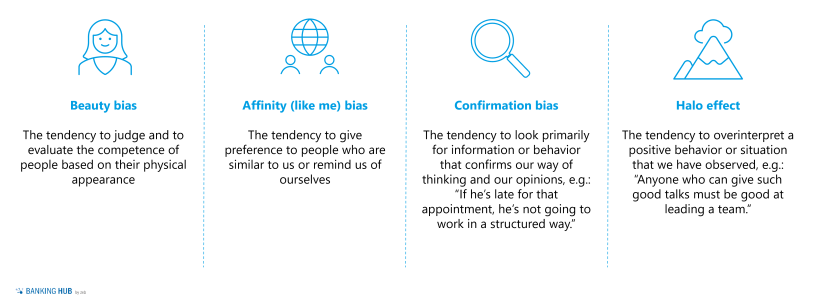Why we should address unconscious biases
It’s harder to crack prejudice than an atom.” Albert Einstein already identified the problem of unconscious thought processes and the stereotypes that may result from them.
Currently, diversity and equal opportunity are topics that get a lot of attention. At heart, it’s about allowing all people the same opportunities and possibilities. Even if we are convinced that we think neither in stereotypes or fixed categories nor pigeonhole people, this issue nevertheless concerns us all.
Overview of unconscious biases: cognitive distortions and thought patterns
Owing to our unconscious biases, companies have to overcome several obstacles to achieve greater diversity and equal opportunity. Since unconscious processes shape our thoughts, and this holds true for all of us, each employee influences the level of diversity and equal opportunity in a company.
Unconscious biases influence the way we treat our colleagues, how we evaluate them, whether we promote them and who we select in the first place.
In general, there are a variety of cognitive distortions or unconscious patterns that impact our thoughts (sometimes more, sometimes less). Here are a few examples:
- The beauty bias is a major challenge for companies: the appearance of applicants and team colleagues is judged and evaluated by our deeply ingrained notions of beauty. Attractive people whose appearance is associated with positive attributes are thus treated preferentially. In some cases, these people are credited with skills and competencies that they may not even have. A strong beauty bias can diminish people’s ability to notice the skills and experience of a person who is “less appealing” to them. This has given rise to the term “lookism”, which refers to discrimination based on physical appearance.
- The affinity bias especially influences whether people feel they belong within a company. Frequently, within different departments or working groups, people distinguish between “us” and “them”. This leads to a pronounced feeling of belonging within a specific group, but not within the company as a whole. The affinity bias also results in distinct silo thinking, and it makes interdisciplinary work more difficult which negatively impacts on the performance of teams or even of entire companies.
- Being dogmatic about an idea or clinging obstinately to specific impressions are typical consequences of the confirmation bias. This bias has an adverse effect on our ability to think critically and objectively. As a result, we interpret information in a distorted way and block out other perspectives. This is a risk with regard to equal opportunity, since, for example, an already prevailing negative impression of a person is reinforced by focusing only on detecting flaws in their work. Through this process, a person seeks to confirm their own perception. At the same time, this may lead to advantages for people who are associated with very positive attributes, even though they do not objectively perform better or worse than others.
- The halo effect is one of the most common biases in performance assessment. In these cases, managers evaluate their employees based on their perception of a single characteristic instead of on the totality of their performance or contribution. For example, if employees are very enthusiastic and positive, this may conceal poor performance. By contrast, introverted employees may receive poorer results in their job evaluation because they are less noticeable and visible on the team, even though they may be making hugely important contributions to the team’s work.
These different unconscious biases often have a negative impact on organizations, and affected individuals are faced with unfair advantages or disadvantages. In addition, biases stand in the way of diversity and a shared corporate culture. Accordingly, it is not sufficient if only individual people address their unconscious biases.
Yet leaders can still pave the way by serving as an example. They often play an important role in decisions, promotions as well as developments and are responsible for creating a healthy and productive working culture and teamworking spirit. This also includes promoting equal opportunities.
For this reason, it is urgently recommended that all managers in companies consistently and continuously analyze their unconscious biases. Ideally, this will become a standard practice not only for managers, but for all employees. It may trigger positive effects – that can spread across the company – and allows employees to give each other feedback on their unconscious biases and to encourage each other to adopt new perspectives.
It is crucial to remember that everyone is different and that different minds offer unique and new perspectives for a productive work environment.
BankingHub-Newsletter
Analyses, articles and interviews about trends & innovation in banking delivered right to your inbox every 2-3 weeks
"(Required)" indicates required fields
Anti-bias strategies: checklist
With the right anti-bias strategies, cognitive distortions can be prevented or, if they occur, people can be made aware of them. As an example, several strategies are described below.
1. Broaden your horizons by including the perceptions of others
Put your impressions to the test – gather feedback from others and try to see the big picture instead of relying solely on your own perceptions. This is always very important when it comes to evaluating employees. In this way, you can check and analyze your personal impressions.
Generally, personal perception can never be judged as right or wrong. The point is to gather different perspectives and perceptions in order to create an overall picture that is as objective as possible. This also involves addressing your own biases.
2. Focus on heterogeneous teams
More diversity in teams through different cultural backgrounds, genders, or even perspectives and interests can help reduce an individual’s affinity bias. Positive experiences can thus be created – which in turn help to reduce silo thinking and to develop a high-performance and team-oriented organization.
3. Use of standards to increase objectivity
If standardized procedures are used when assessing performance or hiring new employees, both the beauty bias and the halo effect can be reduced.
Another method to eliminate the two biases is the “increased transparency principle”. For example, it is helpful and recommended to use clearly defined assessment criteria for recruiting and to further improve them by using different interviewers. This requires a clear competency model and written requirements for applicants.
4. Anti-bias training
Through targeted anti-bias training, managers and employees – especially those with personnel responsibility – learn to better reflect on and assess their own perceptions and decisions. The aim is to avoid or reduce faulty perception and to make decision-making processes in one’s own area of work as bias-free as possible.
This training also teaches people that unconscious biases represent unconscious thought patterns that are not “wrong” per se, but do prevent equal opportunity and diversity. As a result, participants become more aware of their own perception and evaluation. When all employees in a company are trained to reflect on their perception of themselves and others, a dynamic process is set in motion. This encourages them to actively question themselves and check their perceptions for unconscious patterns.
In summary, all of us are prone to cognitive distortions and apply them unconsciously in a variety of situations. On the one hand, this allows us to make decisions more quickly and save resources; on the other hand, decisions that have been made unconsciously can have severe consequences – or lead to individuals being advantaged or disadvantaged.
Biases that frequently occur in the working world include the beauty bias, affinity bias, confirmation bias and the halo effect. However, with the right anti-bias strategies, these distortions can be eliminated.
The first step any company should take is to encourage all managers and employees to address their biases in order to heighten their awareness of unconscious thought processes. Thinking in categories is not “wrong” per se. They help us to be faster, but they can also jeopardize equal opportunity – and in that case unconscious thought processes are flawed and should be corrected.
Addressing unconscious biases also helps to achieve greater diversity. Much remains to be done – especially at regional banks:




